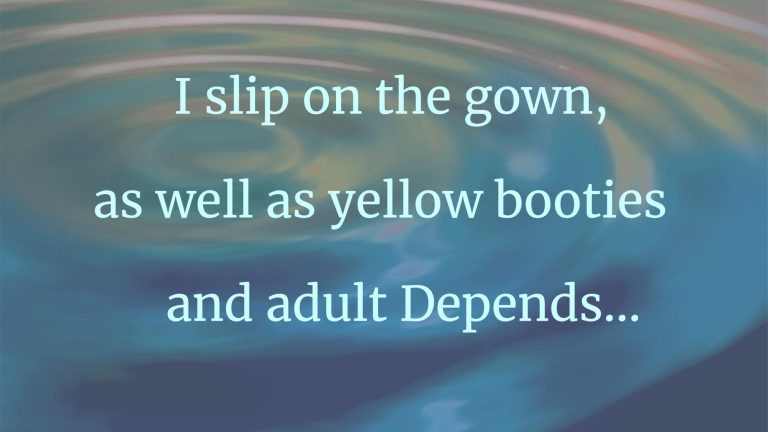
Vital
Everyone is nice to me. First night
through morphine I hear nurses saying
they’ll keep me on the surgical floor,
refuse to send me to the cancer unit.
They know I’m healthy, rich with lifeblood–
why view the damage this disease could do?

Everyone is nice to me. First night
through morphine I hear nurses saying
they’ll keep me on the surgical floor,
refuse to send me to the cancer unit.
They know I’m healthy, rich with lifeblood–
why view the damage this disease could do?

She did not slice the bandage snugged about the numb toe
but tickled an end open to begin the unwinding. She
unwound the gauze slowly as she turned her head
to see where the cloth stuck to itself and how to cut it.

June 2020
I’ve put it off for as long as possible because replacing a knee is major surgery, and things can go sideways fast. Infection is #1 on my doctor’s list of concerns. Blood clots are #2, and I’ve heard stories of people who had clots travel to their lungs and died before they could get to an emergency room.
Pain is at the top of my list. My knee is now bone on bone, and I can’t limp all the way around a grocery store without packing it in.

Donna dropped her blood-thinner tablets on the floor prior to surgery.
“It’s a sign I shouldn’t be taking them,” she said.
Now, sometime later, it makes me smile to think of it; she’s recovered well from the surgery and has resumed her medications. I’d told her to stop taking them just prior to the surgery—a complex hernia repair—and to resume them the day after, but she’s the type of person who does what she wants, what she thinks is best.

if not a healing wound?
toes missing, trans-metatarsal amputation,
remaining tissue puckering deep pink:
raw beauty in disfigurement.
He shows me pictures on his cell phone,
the toes felt doused with molten metal.
Before debridement: brown-black,
the foot decaying like a leaf in winter.

They add colloidal gold
to glass, sometimes,
to make that ruby color. They heat it,
render it liquid and viscous, and
when it is just right,
the master glassblower blows into it,

One spring day last year, I sat in the office of the man who was to be my husband’s heart surgeon, waiting to have one of the most important conversations of my life. My husband, Craig, sat next to me with his guide dog, Chase, at his feet.
The doctor—tall, dressed in surgical scrubs—came in, introduced himself and sat down. His eyes looked kind; his demeanor was serious.

The dank, loamy smell fills my nostrils. I turn my head, but cannot escape the odor. It emanates from me, this nauseating scent of sickness and neglect.
It is five days since the surgery, five days since my right breast and multiple lymph nodes were removed. I cannot bathe or shower.

My grandmother’s bed bounced high
But I lost the pillow in my hands
Four stitches in the small town
green tiled emergency room
where peering intently into the mirrored light
I was mad because I couldn’t see

The year is 2015, and I’m on my thirteenth surgical mission, but my first to Venezuela. I am a plastic surgeon, traveling with a nonprofit that offers free plastic surgery for people with birth defects such as cleft lip. We’re making a two-week visit to the coastal city of Cumaná, 250 miles east of Caracas.
Halfway through our first day of surgery, I’m asked to come out to the waiting area to assess a young girl named Vanessa, whose mother has brought her as a walk-in patient.

Detroit, January 1997
In a haze of sleeplessness, I open the door to the general-surgery call room (aka “the Garage”) just after midnight. I’m one of two third-year medical students on this call team, and if I arrive first, I might be able to avoid the bunks with the most creased sheets and the pillows with head indentations still on them. The entire general-surgery team sleeps in this one room, with its messy bunks for eight and its odor of stale bodies. That is, we sleep during free moments, in rare fits, interrupted by pagers beeping and the door opening with a flash of light and closing with a loud click.
Climbing to an upper bunk, I get beeped: Code 1.
“Fuck, another gunshot victim,”

“There’s a transplant happening today,” said Sophie Lee, a resident, glancing at her pager.
It was a Saturday afternoon, and I was a second-year medical student doing a clerkship on the hepatobiliary surgery service (specializing in the liver and bile ducts).
I felt a pang of disappointment: Now I couldn’t go home until after dinner. But there was no use complaining. I followed Sophie to see the transplant recipient, Mr. Franklin.
© 2024 Pulse - Voices from the Heart of Medicine, Inc. All rights reserved.